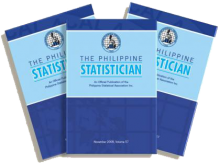| 1. | High dimensional nonparametric discrete choice model | Maureen Dinna D. Giron | 2013 | 62 | 1 |  |
| 2. | Esstimation under purposive sampling with auxiliary variable | John Erwin Banez | 2013 | 62 | 1 |  |
| 3. | Sparse principal component regression | Joseph Ryan G. Lansangan | 2013 | 62 | 1 |  |
| 4. | Value-at-risk measures for the PSE index using hidden markov models | Joselito C. Magadia | 2013 | 62 | 1 |  |
| 5. | Bootstrap estimation of the average household expenditure on personal care and effects of regional level | Jachelle Anne G. Dimapilis | 2013 | 62 | 1 |  |
| 6. | Nonparametric transfer function model with localized temporal effect | John Carlo P. Daquis | 2013 | 62 | 1 |  |
| 7. | Sampling from a Skewed Population: The Sampling Design of the 2011 Survey of Enterprises in the Philippines | Erniel B. Barrios | 2012 | 61 | 2 |  |
| 8. | Robust Methods in Time Series Models with Volatility | Wendell Q. Campano | 2012 | 61 | 2 |  |
| 9. | Poisson Spatial Autoregression Modelling of Poverty Count Data in the Philippines | John Erwin S. Banez | 2012 | 61 | 2 |  |
| 10. | Nonparametric Bootstrap Estimation of the Population Ratio Using Ranked Set Sampling | Kevin Carl P. Santos; Charisse Mae I. Castillo; Reyna Belle d.S. de Jesus; Nina B. Telan; Crystal Angela P. Vidal | 2012 | 61 | 2 |  |
| 11. | Analysis of Mother's Day Celebration Via Circular Statistics | Ali H. Abuzaid | 2012 | 61 | 2 |  |
| 12. | Purposive Sampling as an Optimal Bayes Sampling Design | Jacqueline M. Guarte | 2012 | 61 | 2 |  |
| 13. | Small Area Estimation with a Multivariate Spatial-Temporal Model | Arturo M. Martinez, Jr | 2012 | 61 | 2 |  |
| 14. | On the Misuse of Slovin's Formula | Jeffry J. Tejada; Joyce Raymond B. Punzalan | 2012 | 61 | 1 |  |
| 15. | Ranked Set Sampling | Kevin Carl P. Santos | 2012 | 61 | 1 |  |
| 16. | A Multivariate Probit Analysis on the Factors Influencing the Adoption of Water Saving Technologies by Rice Farmers in Sto. Domingo, Nueva Ecija | Daniel R. Raguindin; Eiffel A. De Vera | 2012 | 61 | 1 |  |
| 17. | Sampling with Probability Proportional to Aggregate Size Using Nonparametric Bootstrap in Estimating Total Production Area of Top Cereals and Root Crops Across Philippine Regions | Maria Sofia A. Poblador; Iris Ivy M. Gauran | 2012 | 61 | 1 |  |
| 18. | Econometric Modeling of Panel Data on the Saving Patterns of Philippine Agricultural Households | Angelo M. Alberto; Lisa Grace S. Bersales | 2012 | 61 | 1 |  |
| 19. | Classification of Congenital Hypothyroidism in Newborn Screening Using Self-Organizing Maps | Iris Ivy M. Gauran; Maria Sofia Criselda A. Poblador | 2012 | 61 | 1 |  |
| 20. | In a number of research studies involving surveys, the so-called Slovin's formula is used to determine the sample size. Unfortunately, many of these studies use the formula inappropriately, giving the wrong impression that it can be used in just about an | Lara Paul D. Abitona; Zita VJ Albacea | 2012 | 61 | 1 |  |
| 21. | Assessing Strength of Seasonality Through Sample Entropy: A Simulation Study | John Carlo P. Daquis; Maria Lizeth M. Laus; Nikki E. Supnet | 2012 | 61 | 1 |  |
| 22. | Statistical Models for Extreme Values | Peter Julian A. Cayton | 2012 | 61 | 1 |  |
| 23. | Sample Sizes to Compare Two Poisson Rates | Edsel A. Pena | 2012 | 61 | 1 |  |
| 24. | Bootstrap Methods | Erniel B. Barrios | 2011 | 60 | 1 |  |
| 25. | A Dose of Business Intelligence: Data Mining | Joseph Ryan G. Lansangan, | 2011 | 60 | 1 |  |
| 26. | Copula-Based Vector Autoregressive Models for Bivariate Cointegrated Data | Hideaki Taima; Ana Maria L. Tabunda, | 2011 | 60 | 1 |  |
| 27. | Nearest-Integer Response from Normally-Distributed Opinion (NIRNDO) Model for Likert Scale | Jonny B. Pornel, Vicente T. Balinas, Giabelle A. Saldaa | 2011 | 60 | 1 |  |
| 28. | Substance Use Among Serious Adolescent Offenders Following Different Patterns of Antisocial Activity | Michelle Besana; Edward P. Mulvey | 2011 | 60 | 1 |  |
| 29. | Food Inflation, Underemployment and Hunger Incidence: A Vector Autoregressive (VAR) Analysis | Dennis S. Mapa; Fatima C. Han; Kristine Claire O. Estrada | 2011 | 60 | 1 |  |
| 30. | Length of a Time Series for Seasonal Adjustment: Some Empirical Experiments | Lisa Grace S. Bersales | 2011 | 60 | 1 |  |

